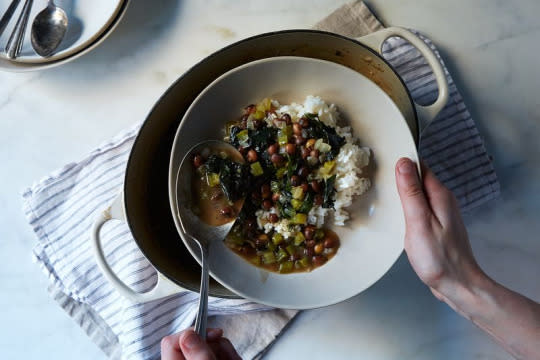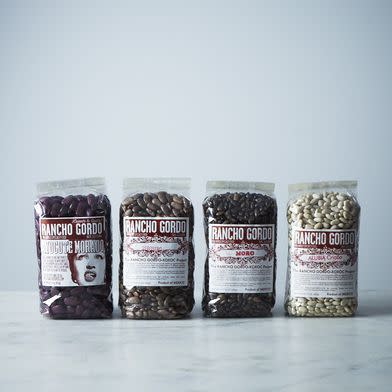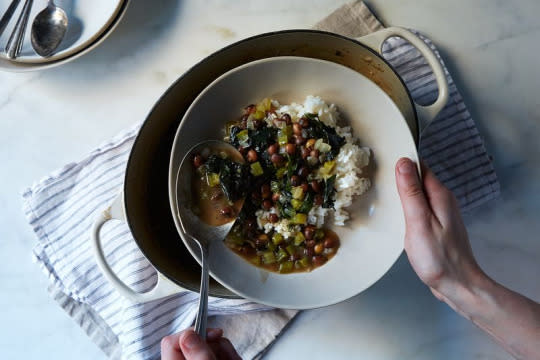A (Vegan) Gumbo with a Trick for Richer Soups
The greater challenge in creating veg versions of traditional meat-based dishes is most often not in replacing the meat itself, but rather layering flavor the meat imparts to a dish typically by way of a rich stock or broth. Often, a good homemade vegetable stock does the trick, but sometimes it’s not quite enough, and this is where I’ve become unapologetically predictable with a trick that has saved many days dishes.
Related: 9 Hearty Vegetable Soups to Carry You Through the Day

Vegan gumbo with beans and greens. (Photo: Julia Gartland/Food52)
Yes, beans are great, but I’m also after something else when I cook them: their cooking liquid. Depending on the bean type, that liquid stands convincingly in place of traditional meat stocks made from chicken, duck, or pork. Ladle it into risotto, simmer it as a base for greens and bean soups, use it as the sauce for pasta e fagioli. It’s also just the thing in a vegan gumbo, where its sweet, earthy flavors give the gumbo richness and depth and pair up well with a nutty roux and bitter greens, or whatever the season calls for.
Related: 13 Wondrous Things to Do with Canned Beans

A hearty soup will carry you through this Winter, I promise. (Photo: James Ransom/Food52)
The choice of bean is up to you, but the key is the dark broth they produce as they cook, so stick to something in the brown/red/gray family. Crowder peas are my preference, but they can be a trick to find outside the South, so most often I fall to pigeon peas, which are pretty easy to find in bulk bins or international groceries; or little red nightfall beans, carried by Rancho Gordo; or the tiny Sea Island red pea, sold by Anson Mills. Other little pink and lavender heirloom beans and pinto-types work well, too.
Related: How to Make Parmesan Broth + 6 Ways to Use It
A few things are crucial to making vegan gumbo besides the bean liquid: the roux—which thickens the gumbo and lays down a foundation of rich, nutty flavor— and the “holy trinity” of onion, celery, and green bell pepper, whose fragrance as it hits the finished roux is one of my favorite scents in all of cooking.
Related: 10 Super Tips for Making Soups & Stews We Learned from the Pros

It’s time to whip out those beans. (Photo: James Ransom/Food52)
Outside of these essentials, different directions are yours to take—in the case of a vegan gumbo, this means vegetables. In cooler months, leafy greens are an obvious choice: the more varieties, the better. I’m pulling handfuls of radish greens, turnip greens, mustards, and collards from the straggling vegetable garden. It’s a combination I love for its mix of spicy, pungent, earthy, and bitter flavors, but if what you have is exactly one bunch of kale or a head of cabbage, you’ll do fine. In spring, I’ll add heaps of celery leaves toward the end of cooking to echo the diced stalks, or use broccoli raab or the sprouts of overwintered greens, cooked just until bright and tender.
Related: The 8 Stews You Should Cook This Season
In summer, I love a more delicate version made with sliced okra and squash blossoms, both added 5 to 10 minutes before serving, or a pepper-heavy version with sweet red bells added with the trinity and more chopped hot peppers added a few minutes before serving. Peeled chopped tomatoes add depth and acidity; shaved fresh corn and seared eggplant bring in sweetness and texture. Fresh field peas—crowders, particularly—should be obvious, if you’re so lucky to have access to them.

Vegan gumbo with beans and greens. (Photo: Julia Gartland/Food52)
I wouldn’t recommend forgoing the thyme, garlic and bay, but layer on more herbs if you have ‘em. Parsley is perfect, stems and all; basil can be lovely, as is bit of marjoram in moderation.
If your audience needs an extra meaty hit, crumble some sautéed seitan sausage over the top. This recipe, by the way, double or triples up easily. And whichever way you go, pass the rice.
Vegan Gumbo with Beans and Greens
Serves 3 to 4
1 cup dry pigeon peas, crowder peas, or small red or brown beans, such as red nightfall
1 bay leaf
2 stalks celery, finely chopped
1 medium green pepper, finely chopped
1 medium yellow onion, finely chopped
2 large cloves garlic, minced
2 teaspoons thyme leaves, chopped
Freshly ground pepper
¼ cup toasted peanut oil
¼ cup all-purpose flour
2 teaspoons salt (preferably smoked)
2 to 3 cups chopped leafy greens (mustards, collards, turnips, radish greens, or a combination)
Steamed white rice, for serving
Soak the peas or beans overnight in a bowl of water to cover by several inches. The next day (or evening, if you started the soak in the morning), drain the beans, add them to a medium-sized, heavy pot, and cover them with 4 to 5 cups water. Add the bay leaf, a pinch of salt, and bring to a simmer over medium heat. Reduce the heat to about medium-low—you want the water to remain at a very low bubble with the pot partly covered. Simmer for 45 minutes or so, until the beans are just tender. If your beans are particularly fresh, this might only take 35 minutes; older, an hour or more. Remove from the heat, cover with a lid, and allow the beans to rest for at least 30 minutes. Leave them in their liquid; you’ll need to use it later.
While the beans are resting, start the roux. Heat the oil in a 3- or 4-quart Dutch oven over medium-low heat. Sprinkle the flour over the oil, and whisk until smooth—a flat whisk works well here. Whisk the oil-flour mixture for a few minutes, then switch to a wooden spoon, and stir, constantly, as the roux begins to darken to a dark caramel color. The time it takes to reach this shade depends on the heat you’re using, but count on around 20 to 30 minutes at medium-low.
Once the roux has reached a deep caramel color, add the onions, green pepper, and celery (the roux will coat the vegetables in a way that may make you think you’re doing something wrong, but don’t worry). Stir for a couple of minutes, add the garlic, thyme, and a good several grinds of black pepper, and saute for another 7 to 8 minutes, until the vegetables are light golden around the edges and begin to wilt.
Now pour off about 2 cups of the bean-cooking liquid, and pour it into the pot with the vegetables. Add the salt. Whisk well, bring to a simmer, and cook for about 5 minutes, until the broth thickens. Add the beans and any remaining liquid (you should have another ¾ cup or so), and cook for a few minutes more. After about 10 minutes, add the greens, and simmer gently until their texture turns silken, anywhere from 2 to 3 minutes to 10. Season to taste with additional black pepper, and serve with white rice. Serve leftovers with more rice, or cornbread.
Save and print the recipe here.
By Emily Horton.
